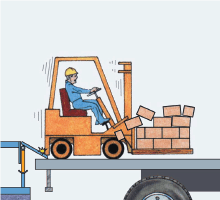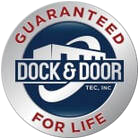|
Stump-out? Like the chemical that is used to get rid of unwanted tree stumps? What does that have to do with loading dock equipment? No, we’re not talking about that kind of stump-out. In the loading dock industry stump-out is an all too common problem and huge cost of ownership with mechanical dock levelers that can wreak havoc and create a hazardous work area.
What is it? Ironically enough, stump-out is caused by pieces of the dock meant to keep it safe. Stump-out occurs on mechanical dock levelers when the mechanical fall safe legs contact their stops. The legs then interfere with the vertical movement of a dock leveler that naturally occurs during loading and unloading. Stump-out can also occur when mechanical fall safe legs can be manually released by pulling a release activator in the dock leveler deck assembly. The release is required every time the dock leveler must pass the below the stop position of the mechanical fall safe legs. Upward movement during use can cause the safety leg to reset to the stored position. How do I know if I have stump-out? Take a look at your dock while it’s in use. Does it look like this? Do your forklift drivers complain about big bumps or jarring stops going in and out of trucks? Do your forklifts have tire damage that isn’t normal wear and tear? Does your product ever take a spill off pallets while being loaded or unloaded? If so, you probably have a stump-out situation happening. The consequences No matter how it happens, stump-out creates a steep incline of the lip. That, in turn, causes any lift truck to be severely jarred or stopped completely when trying to exit a truck, causing possible injury to the driver or damage to any product being moved, the lift truck, or the leveler itself. While there are designs and versions of mechanical fall safe legs that can remain retracted until they are required, they do not always activate like they should. Many times they are activated by lip rotation or speed sensing. Rollers and spring-loaded cross-traffic legs do not solve the stump out problem and add to the cost of ownership. They are high failure rate parts and are in constant danger and motion during loading and unloading. All of which will cost you time and money. Lots of time and money. In some cases, there are as many as 20-30 parts for EACH mechanical fall safe leg that can fail. Over and over again. With some of our own clients, we have seen repair bills that would have covered the difference of purchasing a hydraulic leveler in the first place. And would have more than covered the cost of a hydraulic conversion. Stump-out also poses a major safety risk to your employees. Constant jarring and sudden stops can cause back and neck injuries. In turn, costing you downtime due to injury and potential worker’s compensation claims. As well as employee safety, what about your equipment? The jarring and sudden stops cause repeated damage to your forklifts and other equipment that will all-cause premature wear and tear. Meaning you will need more maintenance and sooner replacement. All causing you downtime and efficiency deficiency. How to fix it? Instead of throwing parts and money away trying to fix a problem that will keep happening no matter how good your service team is, address the problem head-on. Most loading dock companies are representing a single manufacturer and have a very limited number of solutions. As an independent loading dock service & repair company, we have options that work for all situations. We will assess your situation and work with our partners to design a solution that works for your facility and your budget. For more information, contact us and we will provide a solution for this potentially costly and hazardous problem. Comments are closed.
|
AuthorVarious. Categories
All
Archives
August 2023
|
- Home
- About
- Career Opportunities
- Services
-
Equipment
- Dock Locks (Truck Restraints) >
- Fans & In-Plant Equipment >
-
Industrial / Commercial Doors
>
- High Speed Fabric Doors
- Security High Speed
- Rubber Doors
- Fire Door
- Rolling Steel
- Impactable Dock Doors
- Cooler / Freezer
- Fabric Roll-Up
- Impact / Traffic / Bump
- Overhead / Sectional Doors
- Operators / Activation
- Air Curtains / Screen & Bug Doors
- Strip Doors
- Door Entrapment Protection
- Door Protection
- Overhead Door Upgrades
- Loading Dock Levelers & Lifts >
- Loading Dock Seals & Shelters >
- OEM & Aftermarket Parts
- Safety / Energy / Security / Employee Comfort >
- Yeti Snow Removal
- Markets
- Blog
- Contact
Dock & Door Tec
Serving Minnesota, Wisconsin, Iowa, North Dakota & South Dakota
Serving Minnesota, Wisconsin, Iowa, North Dakota & South Dakota


 RSS Feed
RSS Feed
